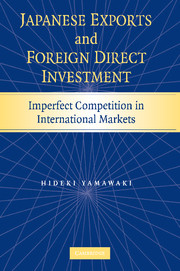Book contents
- Frontmatter
- Contents
- Tables
- Figures
- Preface
- 1 Introduction
- 2 Export Pricing Under Imperfect Competition
- 3 Export Price, Learning, and Domestic Demand Disturbances
- 4 Foreign Market Structure, Export Price, and Profitability
- 5 Competitive Advantage and Export Performance
- 6 Entry in the European and U.S. Manufacturing Industries
- 7 Strategic Interactions in Cross-Market Entry
- 8 Responses of Foreign Firms to Japanese Competition
- 9 Exit in the U.S. Manufacturing Industries
- 10 Interpreting the Empirical Findings
- 11 Implications
- Appendixes
- References
- Index
9 - Exit in the U.S. Manufacturing Industries
Published online by Cambridge University Press: 08 January 2010
- Frontmatter
- Contents
- Tables
- Figures
- Preface
- 1 Introduction
- 2 Export Pricing Under Imperfect Competition
- 3 Export Price, Learning, and Domestic Demand Disturbances
- 4 Foreign Market Structure, Export Price, and Profitability
- 5 Competitive Advantage and Export Performance
- 6 Entry in the European and U.S. Manufacturing Industries
- 7 Strategic Interactions in Cross-Market Entry
- 8 Responses of Foreign Firms to Japanese Competition
- 9 Exit in the U.S. Manufacturing Industries
- 10 Interpreting the Empirical Findings
- 11 Implications
- Appendixes
- References
- Index
Summary
In Chapter 6, we examined the pattern of Japanese entry in the European and U.S. manufacturing industries in the late 1980s when the explosive increase in the flow of FDI was observed. What happened to those Japanese firms that rushed into Europe and the United States? Did they exit already from these markets? In fact, a number of Japanese firms that entered in the U.S. and European industries in the 1980s have left these markets by now. The purpose of this chapter is two-fold: first, it examines the pattern of Japanese exit from the United States through 2000; second, it tests several hypotheses on the relationship between concentrated entry and exit patterns.
Patterns
The data used to describe the exit pattern of U.S. subsidiaries of Japanese firms is constructed from the subsidiary level information published in Toyo Keizai, kaigai shinshutsu kigyo soran and described fully in Chapter 6. The sample of Japanese subsidiaries used in this chapter is generated by the following criteria: (1) the subsidiary is in manufacturing; (2) the Japanese parent firm is in manufacturing; (3) the subsidiary was established during the 1985–1990 period; and (4) the Japanese parent owns more that 10 percent of the subsidiary. These criteria and the unavailability of some of quantitative data on subsidiary, parent, and industry characteristics produce a sample of 316 subsidiaries in the United States. The 1985–90 period records the highest concentration of Japanese entries into the U.S. market in any 5 consecutive years in history.
- Type
- Chapter
- Information
- Japanese Exports and Foreign Direct InvestmentImperfect Competition in International Markets, pp. 162 - 177Publisher: Cambridge University PressPrint publication year: 2007



